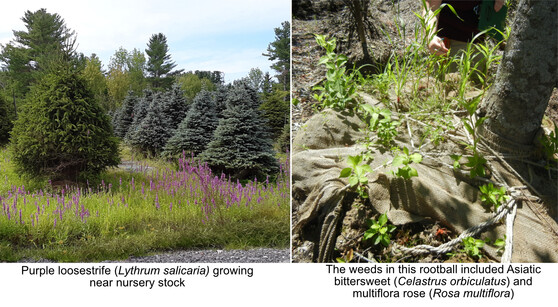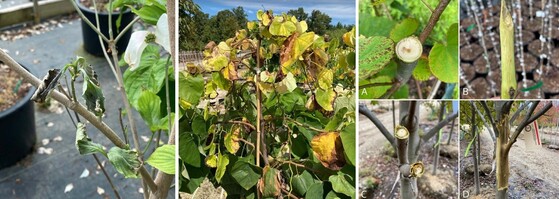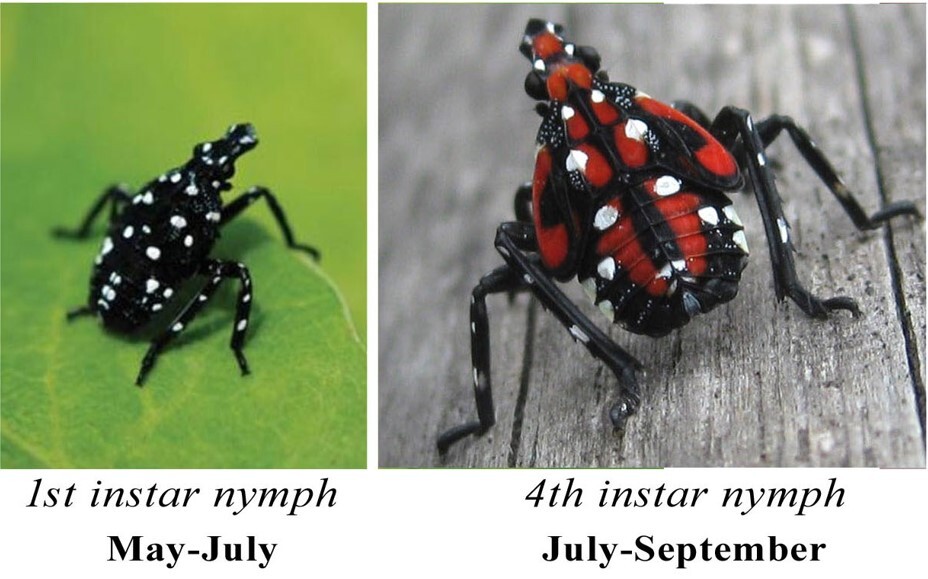MELeaf: A Newsletter From the Horticulture Program, July 11, 2023
In this issue:
The DACF Horticulture Program has a new cooperative agreement with USDA-APHIS to provide outreach and education to plant sellers (nurseries, greenhouses, garden centers, box stores, master gardeners, and others) about the invasive plants and noxious weeds that may become horticultural hitchhikers in plant pots, root balls or other horticultural materials (compost, soil materials, leaves) and provide best management practices to prevent the invasion and spread of noxious weeds and invasive plants into plant production, holding, display or sales areas.
Caley Rentz Boomer is our Education and Outreach Coordinator, and she will:
- Develop and design educational materials, including bookmarks, posters, signs, plant tags, brochures, and related website resources.
- Plan and coordinate one statewide noxious weed and invasive plant management workshop focusing on best management practices to prevent infestation and to stop the spread of noxious weeds and invasive plants. The workshop will be provided in person and virtually through the MS Teams platform.
- Plan and coordinate up to five regional noxious weed/invasive plant training sessions, including hands-on instruction and plant tags and signs distribution.
- Provide information on plant alternatives to invasive species, including native plants and non-invasive alien plants.
- Provide hands-on assistance to plant sellers that want to control noxious weeds or invasive plants growing near production, holding, or sales areas.
- Develop identification tools/keys for noxious weeds and invasive plants that might invade plant production, holding, or sales areas, especially for recognizing plants in seedling stages.
This training and outreach will help prevent the invasion and establishment of the noxious weed, mile-a-minute (Persicaria perfoliata), and other invasive plants like stiltgrass (Microstegium vimineum) into horticultural materials being sold and reduce the potential for subsequent spread into forests, agricultural lands, and sensitive habitats.
The project will also assist the state with its own invasive plant regulatory outreach regarding 30 newly listed invasive plants that will no longer be legal to sell after 1/1/2024 and with one plant (Rosa rugosa), which will require special tagging or signage at the point of sale.
If you'd like to give us your input on what types of outreach materials are most useful for your business, please consider taking our short survey. Survey responses are being accepted until July 14.

Box tree moth (Cydalima perspectalis) is a serious invasive insect that can significantly damage and potentially kill boxwood plants (Buxus spp.). Caterpillars feed on the leaves and bark of boxwoods leading to defoliation and girdling. Native to Asia, box tree moth was discovered in Canada in 2018 and has since spread to New York, Michigan, and Ohio. Infested areas have been quarantined by USDA to prevent further movement of the pest within the United States.
Box tree moth caterpillars overwinter and will begin feeding when temperatures reach approximately 50°. Depending on climate conditions, box tree moth can have up to 5 generations per year. After a short pupation period, adult moths become active. In Ontario, adults are observed between late June through September, suggesting there may be only 2 generations per year in our region.
Although adult moths are strong fliers, dispersing as much as 6 miles per year, long distance spread is primarily through infested nursery stock. To protect this commodity, look for these signs and symptoms on your Buxus stock:
-
In the spring, look for a “peeled” appearance on the leaves caused by young caterpillar feeding underneath (photo 3).
-
As the season progresses, look for defoliation of entire leaves sans the midrib (photo 4).
-
Look for girding on twigs.
-
Look for white silken threads as mature caterpillars web together leaves for pupation.
-
Look for adult moths throughout the growing season. They are medium sized (~1.5” wingspan), often white with a brown border (photo 1), although some can be entirely brown (photo 2). Both color morphs have a distinctive white forewing spot shaped like a comma. The closest lookalike would be the melonworm moth (Diaphania hyalinata), which is rarely encountered in Maine.
 photo 1 (Ian Redding): Box tree moth adult – light morph; photo 2 (Juergen Kottmann): adult – dark morph; photo 3 (Mujezinovic Osman, Faculty of Forestry, bugwood.org): mature caterpillar and your caterpillar feeding damage (“peeling”); photo 4 (Ferenc Lakatos, University of Sopron, bugwood.org): heavy defoliation showing midribs of leaves left behind.
We first started hearing about vascular streak dieback about a year ago. At the time the problem seemed to be primarily associated with redbud, but recently some states are reporting a much broader host range. The most frequently affected plants in nurseries are redbud, dogwood (flowering and Kousa) and maples. The fungus Ceratobasidium theobromae is thought to be the cause of this disease, but scientists are still working on confirming this. To the best of our knowledge, vascular streak disease has not been found yet in Maine. Keep an eye out for these symptoms:
- Leaf chlorosis and marginal burn
- Wilting and/or stunting of the current year's growth
- Wilting that may lead to death of individual branches and eventually entire plants
- Vascular discoloration may be seen when the bark is scraped back or in cross section when a branch is cut. However, vascular discoloration may not be present in all hosts, such as dogwood.
- Sometimes cankers from secondary pathogens like Botryosphaeria or Phomopsis may develop.
Vascular streak dieback symptoms can be easily confused with other plant problems including Verticillium wilt, root rots, borer damage and environmental stressors. When in doubt, consult a plant pathologist for a definitive diagnosis.
There are not currently any recommended pesticides or other treatment options other than rogueing and burning infected plants. Best management practices that can help reduce the risk of introducing and spreading vascular streak disease include:
- Maintaining plant health and avoiding plant stressors by planting at the correct depth and applying appropriate amounts of water to new plantings
- Sanitize pruning tools regularly
- Remove pruned plant parts and do not leave them on the ground under plants
- Scout plants regularly looking for signs of insects and diseases
- If possible isolate symptomatic or unhealthy looking plants
- Avoid comingling plants obtained from different vendors whenever possible
More Information (including many pictures!) from Virginia Cooperative Extension
 Vascular streak dieback symptoms: flowering dogwood branch wilting from the tip downward towards the main stem (Photo by Devin Bily, Virginia Department of Agriculture and Consumer Services), redbud leaves with yellowing and leaf scorch (Photo by Nicole Kopas, Virginia Department of Agriculture and Consumer Services) and vascular discoloration on redbud (A and B) and maple (C and D) (Photo by Devin Bily, Virginia Department of Agriculture and Consumer Services)
Nursery inspectors have focused on greenhouse inspections longer than usual this year due to the rainy weather preventing outdoor nursery inspections. Aphids continue to be the most common pest in these locations though mites and thrips have started being observed with more regularity. The late frost in May damaged many plants including vegetables, herbs and tender perennials that weren’t properly protected. Inspectors saw several annual crops with virus-like symptoms this year. The suspicious plants that were tested were found negative for viruses and symptoms are believed to have been caused by genetic mutations or nutritional problems. It is important to note however that testing plants with viral symptoms is critical to know if plants need to be rogued to prevent spread to other plants, especially when pest vectors such as thrips are present. Due to the moist weather conditions, many infections of powdery mildew and botrytis (gray mold) have been seen as well as increased populations of snails and slugs. Japanese beetles have yet to be observed by staff this year, however rose chafers seem to have emerged and are feeding on fruit, vegetable and ornamental plants.
Browntail moth - Most browntail moths have entered their pupation phase, although a few lingering caterpillars may still be observed in some areas. Browntail moth cocoons are full of the toxic hairs, avoid handling cocoons. However, cocoons on plants offered for sale should be removed before leaving the nursery or garden center; be sure to take all the necessary precautions to minimize exposure. Adult browntail moths are already emerging in some areas and will be flying throughout the entire infested area soon. Consider reducing or eliminating the use of outdoor lights to avoid attracting adult moths to your property at night. More browntail moth information from the Maine Forest Service
Spotted lanternfly - Continue to look for spotted lanternfly on incoming plant material and scout previously received for nymphs. We have seen reports from Maryland that some nymphs are at the 4th instar stage (when they start to develop the red coloration), but we can expect any insects coming from cooler areas to still be at the earlier nymphal stages and to still be mostly black with white dots. Report any suspect SLF by collecting a sample and sending a picture to horticulture@maine.gov.
 Spotted lanternfly nymphs
|